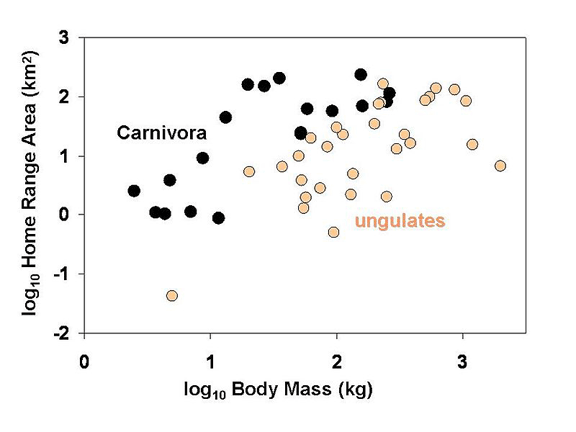
The comparative method
"The comparative approach is not new. Indeed, it was Darwin's favoured technique. ... In short, comparative studies have taught us most of what we know about adaptation." (Harvey and Pagel, 1991, p. v)
How is this graph using correlation and the comparative method?

But consider this quote.
"Yet, one of the most embarrassing things that could be done to a group of respected biologists would be to ask them to spend a few minutes to write down what is meant by the comparative method, and what are the basic goals and principles of biological comparison." (Bock, 1989, p. 18 [cited in Starck, 1998, p. 110])
Why? Because so much of what "should" be compared depends on the questions asked?
So the comparative method in some sense depends on us knowing what to compare which depends on organisms relationships or phylogeny.
This is a film about classic example of using phylogeny to examine such relationships.
Usually if you are using the comparative method you are trying to test relationships as seen in the film, or you are asking a question about some adaptation.
Usually researchers are trying to establish the role of "environmental signals or pressures" versus the role of "phylogenetic signals", or what we have termed historic constraints, shaping the adaptation.
Classic examples:
Example one: Strong environmental signal. Usually this signifies the adaptation came about 100 % as natural selection working on the trait in a particular environment.
Illustration of the assembly of oak communities in northern Florida.
Here it is obvious that distantly related species change morphology with habitat. The implication then is that this is an adaptation to the environment and not due simply to the trait being inherited form an closely related ancestor they all shared.
Caution: The above trend is not observed in all investigations of plant communities. In large-scale studies of plant communities, such as tropical forests, several studies have detected significant clustering of related species, likely due to shared habitat preferences across broad clades (Webb, 2000).
Another example: The evolution of feathers. Old idea again was that feathers evolved with and for flight in birds. The new idea is that they evolved for another purpose, perhaps insulation, and have been refined for flight in modern birds and their more immediate ancestors. Here we have what I term a strong historic or phylogenetic signal.
If you do not use a phylogeny or account for the groups" evolutionary history" then you are assuming that any species used in your comparison are independent points (mathematically) or evolutionary history doesn't matter.
But we all share a history, so when can you treat species as independents? This is the practical problem facing all comparative studies. Adequate sample size is another.
Strict independence versus strong phylogeny among species
In most cases assuming independence will cause overstatement of the significance in hypothesis tests.
Example: Consider if we only had six species, but they really clustered into two groups because of relatedness.
In reality, we have two points, not six.
In some studies that involve more closely related species in which the phylogeny is known, methods have been developed to accommodate historic or phylogenetic effects.
Example: Testis size in bats relative to social group size. Are the sizes of the testes really correlated to group size? What if all species of bats that form small social groups are descended from one ancestor that had small testes and all species of bats that form large social groups are descended from a different ancestor with large testes?
Felsenstein's method
One way of many to minimize the problem. Focus on the divergence in testes size relative to group size in sister species. Asking, as a sister species evolved greater group size did they evolve larger testes?
Felsenstein's method applied to the bat data.
The take home message is the information you conclude from a phylogenetic comparative study is only as good as the trees used. Also to ignore phylogeny can lead to a correlation whose significance is influenced more by relatedness than the two variables being considered. Luckily for the bat study, this was not the case.
As indicated at the end of the film, there are many uses for trees that have nothing to do with the study of a particular adaptation or reconstruction of phylogeny. Below are examples of how relationship trees have played an important role in Epidemiology and Conservation research.
Examples:
http://evolution.berkeley.edu/evolibrary/article/0_0_0/phylogenetics_15 (first example)
https://evolution.berkeley.edu/evolibrary/article/medicine_0
https://evolution.berkeley.edu/evolibrary/news/070101_libya
http://evolution.berkeley.edu/evolibrary/article/0_0_0/conservation_08
http://evolution.berkeley.edu/evolibrary/article/0_0_0/conservation_10 (2 pages)
http://evolution.berkeley.edu/evolibrary/news/081201_phylogeneticconservation